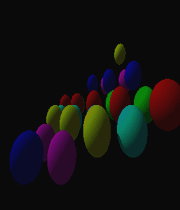|
ExRay
A Ray Tracer with Modelling Support
Table of Contents
- What is ExRay
- Copyright
- System Requirements
- Installation and Use
- Command Line Arguments
What is ExRay
Well first of all, let me thank you for been interested
in this program. ExRay is a ray tracing program.
One famous ray tracing program is Povray, the basic idea is
that you can describe a scene in terms of geometric shapes
(eg spheres and planes) and then ExRay draws the scene and
saves it into a graphics image file.
ExRay grew out of a competition: the Third Annual ICFP Programming
Contest 2000. The task specification of the competition defines
the entire requirements of ExRay. You can find out about what
ExRay is about and the theory behind ray tracing by visiting
the competition web
site. If too much time has past and the people at Cornell
decides to take the sitedown, you can still get a copy of
the task specification (in PDF and PostScript format) from
the ExRay
home page. It is recommended that you at least be familiar
with the GML scripting language before using ExRay. To gain
an idea of GML, you can follow the links in the competition
task specification. For most jobs simply reading the specification
paper would be good enough.
Currently version 0.1 of ExRay only implements Tier 1 features
as defined in the specification paper. So only 'sphere' and
'plane' geometric objects are available and you can only 'union'
objects together. This is already enough to set up quite amazing
scenes — checkout the ExRay home page. I do intend to
complete all 3 tiers of functionality, but it will most probably
take a few years (as you expect I am busy with other things).
I may even add neat features that's not in the specification
just to make it ExRay a better ray tracer to use. So watch
out for future releases of ExRay.
Copyright
ExRay is Copyright (c) 2001 Lawrence Yao
Lawrence is the current maintainer of the software. Authors
of the program includes: John Lai, Harvey Tuch, Simon Bowden,
Stephen Farrar, Jason Au, and a few others (email me if I
missed you). They have written the software during the competition
days, Lawrence have taken over the software since to develop
it further; the result being what you see now.
ExRay is free software, it may be copied and distributed
under the GNU General Public License. Please see the file
COPYING bundled with this package for more details. ExRay
comes with ABSOLUTELY NO WARRANTY, USE AT YOUR OWN RISK, the
authors and maintainer disclaims any responsibility for any
kind of damages arising from the use of this program.
System Requirements
You will need to have at least the Java Runtime Environment
(JRE) version 1.2.2 installed on your system to run ExRay.
JRE 1.3.0 or later is recommended as we have discovered some
problems with the Java VM in Java 1.2. ExRay does not have
a Graphical User Interface, so you will need to have a way
of typing command lines in your operating system to pass information
to ExRay.
Your operating system also needs to support input redirection
as ExRay reads from standard input and writes to file. ExRay
is not very fast: firstly because it is written in Java, secondly
because rendering is not optimised. As a rule of thumb you
can probably run it on a 486 computer if you have enough memory.
Installation and Use
Simply unzip the package you have downloaded, all files
are stored inside the exray-0.1.0 directory.
Within the directory, the ExRay.jar file can be used directly
to render images if you have Java installed already and set
up properly. Use the command:
java -jar ExRay.jar < scene.gml
to render a image from the GML script file scene.gml
(file name is only an example, it can be anything you want).
Any outputs are written away to PPM image files specified
in the script. Note that ExRay reads from standard input and
outputs to files of PPM image format, that's why you need
to use redirection on the scene file. The XV viewer for most
Unix systems can understand PPM format image, for Windows
you can download Irfan View from http://www.irfanview.com
to view the files.
You may want to download the sample scene files from the
ICFP website or the ExRay home page and render them yourself
for practice. Currently ExRay does not take any command line
arguments of any form. If you have some suggestions for command
line arguments, you can email
the maintainer with your suggestions.
Command Line Arguments
The current version 0.1.0 does not support any command line
arguments.
|

